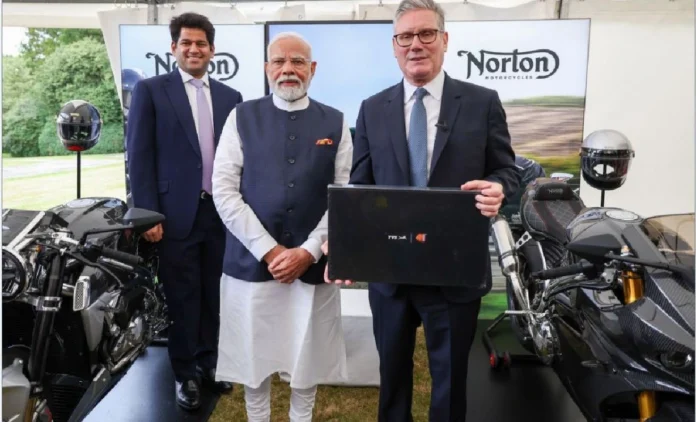By Annunthra Rangan
India has inked its most consequential Western trade pact in over three decades—the long-anticipated Comprehensive Economic and Trade Agreement (CETA) with the United Kingdom. Signed last week, the deal reflects both economic foresight and geopolitical calibration. It is India’s first major Free Trade Agreement (FTA) with a Western economy since the EFTA pact in 2024 and marks a deliberate shift in New Delhi’s global trade posture.
More than just a trade document, the agreement positions India as a serious contender in global supply chains, with targeted gains in exports, investment, services, and innovation. For the UK, still navigating post-Brexit turbulence, the FTA is a landmark step towards economic reintegration with emerging markets. In a world where trade is increasingly weaponised, this deal is being hailed as a strategic economic win for both sides.
With this accord, India’s FTA portfolio now spans 13 comprehensive agreements and six preferential trade arrangements. This expansion aligns with New Delhi’s infrastructure push—new industrial corridors, multi-modal logistics networks, and a digitalised export ecosystem are accelerating India’s shift to an export-led growth model.
WHAT THE DEAL COVERS
At its core, the agreement achieves near-complete tariff elimination and expands access to services and public procurement markets. It incorporates safeguards for environmental and labour standards while promoting forward-looking investment and innovation commitments. About 99 percent of India’s export tariff lines—across textiles, leather, gems, engineering goods, and marine products—now enjoy duty-free access to the UK market, a significant leg-up for Indian exporters long hindered by trade barriers in advanced economies.
Even in agriculture, traditionally a sore point in trade talks, India has secured zero-duty access for 95 percent of its agro and processed food exports, while wisely retaining protections on sensitive items like dairy and edible oils.
A key beneficiary of the pact is India’s MSME sector. Duty elimination on labour-intensive products such as footwear, toys, handicrafts and textiles is expected to energise small manufacturing clusters in Tamil Nadu, Gujarat, Uttar Pradesh and West Bengal. The government is actively nudging MSMEs to upgrade production capacities and scale up to meet global quality standards.
SERVICES, MOBILITY, AND INVESTMENT
Perhaps the standout feature of the FTA is its expansive services chapter. The agreement eases visa norms and enables mutual recognition of professional qualifications for Indian engineers, IT experts, chefs, and healthcare professionals. A major win: Indian workers posted in the UK will be exempt from paying into British social security for up to three years, significantly improving net incomes. India’s burgeoning services sectors—IT, fintech, education and consulting—stand to benefit from simplified cross-border data flows and workforce mobility.
In the investment domain, the FTA is already attracting UK commitments exceeding £6 billion in cutting-edge sectors like AI, aerospace, defence, medtech, and dairy. These investments align with India’s “China plus one” strategy, positioning it as a resilient and attractive alternative manufacturing hub. Legal assurances on investment protection included in the agreement further strengthen investor confidence.
STRATEGIC SOVEREIGNTY RETAINED
Crucially, India has not conceded ground on contentious issues like pharmaceutical patent extensions or data exclusivity, safeguarding its generics industry. The UK’s controversial Carbon Border Adjustment Mechanism (CBAM), seen by many as a tariff disguised as climate policy, was deliberately left out of the deal—avoiding a flashpoint for now.
Meanwhile, over 30 Indian products—including Darjeeling tea, Kolhapuri chappals, and Basmati rice—have gained Geographical Indication (GI) recognition in the UK, reinforcing brand value in premium markets.
UNEASE AT HOME
Not all responses have been celebratory. Domestic whisky makers have flagged concerns over phased duty reductions on scotch, fearing market disruption. Automakers, too, are watching warily. Another sensitive clause: British firms will now gain access to India’s vast government procurement sector—especially in clean energy and transport—raising eyebrows among local industry stakeholders.
Moreover, while the agreement covers broad sectors, critical areas such as financial and legal services remain outside its scope. A separate bilateral investment treaty is still under negotiation.
A 1991 MOMENT—WITHOUT THE CRISIS
The timing and tone of this agreement draw parallels to the 1991 economic reforms, which liberalised India’s economy amid a balance-of-payments crisis. Then, India was forced to open up. In 2025, it is doing so by choice—with confidence and long-term strategy.
Unlike 1991’s survival-driven adjustments, this FTA is about competitive positioning in a post-Covid, geopolitically fragmented world. India is no longer reacting to crisis, but proactively shaping its trade future.
That said, challenges remain. Joblessness, regional inequality, and structural bottlenecks still threaten to undercut potential gains. But from 1991’s hesitant liberaliser to 2025’s strategic negotiator, India’s economic evolution is undeniably global—and deliberate.
—The writer is a Senior Research Officer at Chennai Centre for China Studies. Her research interests constitute China-WANA (West Asia and North Africa) relations and human rights


